How to Choose a Good Badminton Racket
This page offers you a guide on how to choose your own badminton racket.
A common mistake made by most people is that they use the racket that their favourite badminton player uses.
Different people have different styles of playing badminton. Some rackets may be suitable for some but not for others.
Use a racket that works to your strengths!
Before you choose your own badminton racket, ask yourself whether you want to play a game of POWER or CONTROL (i.e. using a power racket or control racket)
You cannot have both power and control in one racket. However, you can choose to have a balance of both.

The picture above shows the names of the different parts of a racket.
How do you know whether a badminton racket is good?
When choosing your badminton racket in a shop, you can do a few simple things to test the quality of the racket.
Stiffness/Flexibility
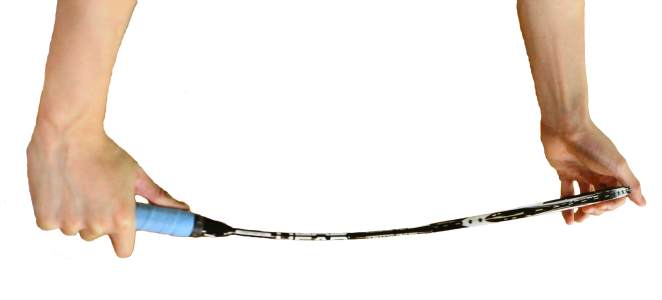
Hold both ends of the racket and bend it slightly -please be gentle when you’re in the shop 🙂
If the racket is easily bent, it has a flexible shaft or otherwise, a stiff shaft.
Accuracy in Placing Shots
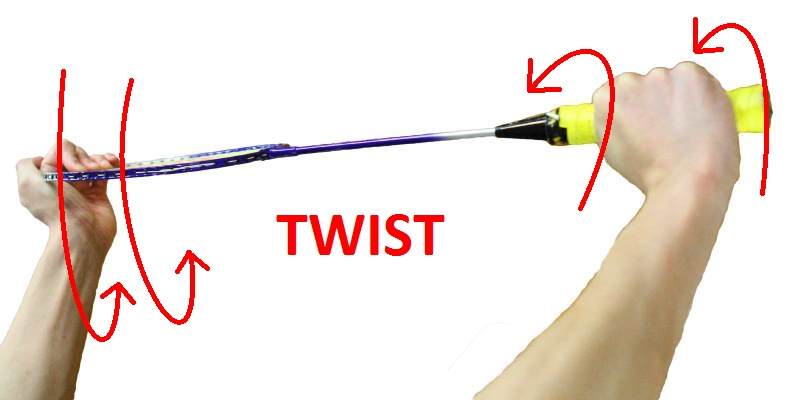
Hold the racket handle with one hand and use your other hand to twist the head of the racket sideways. If the head of the racket does not twist, it’s perfect for shot placement. Flight direction is more certain when the racket head does not twist easily.
Things to Consider When Choosing Your Own Badminton Racket
- Weight
- Balance Point
- Stiffness of Shaft
- Shape of the Frame
1. Weight
With today’s technology, a good badminton racket should weigh 85 -92g (without the string and grip).
A heavy racket is considered a power racket. Heavier rackets accumulate more momentum during your badminton swing, hence giving you more power.
The downside is that a heavier badminton racket is harder to control. It’s also less comfortable handling a heavy racket.
Therefore, if you want to play a game of control, lighter rackets will be perfect for you.
Sometimes, the weight of a racket is classified into a few categories, namely:
2U: 90-94g
3U: 85-89g
4U: 80-84g
5U: 75-79g
3Us and 2Us are common in the market, whereas 4U and 5U are rare.
The weights described above do not include the weight of the badminton string and the grip.
Therefore, when you’re testing a badminton racket in a shop, take into account that the racket will be heavier after you string it and add a replacement grip.
2. Balance Point
This is the point on the badminton shaft that indicates the CENTER of the badminton racket.
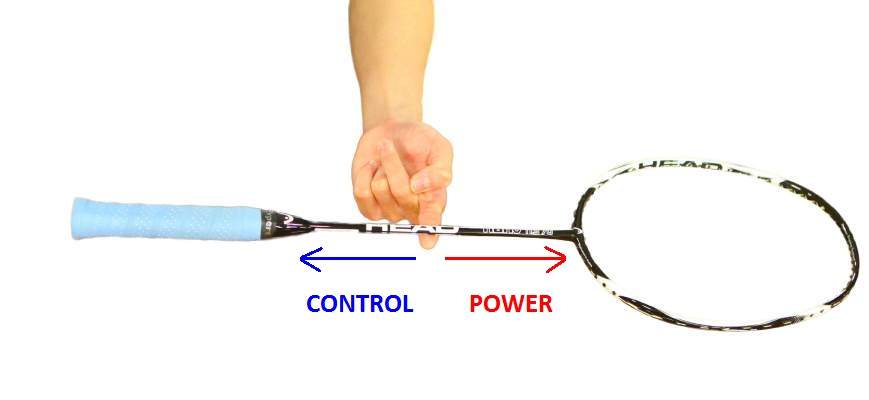
The picture above is a simple test to find out about the balance point of your racket.
- If your finger is closer to the racket head, it has a HIGHER balance point. Therefore it’s more of a POWER racket.
- If your finger is closer to the racket handle, it has a LOWER balance point. Therefore it’s more of a CONTROL racket.
You can adjust the balance point of your racket to suit your playing style even after you have purchased the racket.
If you prefer more control
You may add more weight on the handle:
- Wrap 2 badminton grips
- Wrap a heavier badminton grip
- Use lighter/thinner badminton string
If you prefer more power
You may add more weight on the racket head:
- Wrap a lightweight badminton grip
After making some weight adjustments to your racket, you can always use the same test above to identify the balance point of the racket.
In order to create a more suitable racket for yourself, read more on badminton strings and badminton grips.
3. Stiffness of Shaft
When you’re choosing a badminton racket, you have a choice between a flexible or stiff racket shaft.
A flexible shaft can bend easily, whereas a stiff shaft can hardly bend.
Before buying a baminton racket, pay attention to the stiffness of your racket. You can adjust the weight and balance point of a racket after the purchase. But the stiffness of the racket is fixed.
However, a racket shaft, like all other equipments, will ‘season’. This means that over time, it’ll become less stiff to a certain extent.
The table below tells you whether a stiff or flexible shaft suits your playing style.
Flexible Shaft
| Repulsion: Good |
| A flexible shaft offers good repulsion of the shuttlecock in a badminton swing. This is because a flexible shaft bends slightly towards the back and stores energy during your swing motion.As the shuttle comes into contact with the string bed of the racket, the stored energy will be released and then transferred to the shuttlecock.
Therefore the holder of the racket does not have to exert too much strength for badminton shots such as badminton clears from baseline to baseline. |
| Shuttlecock Placement: Less Accurate |
| Since the shaft of the racket is flexible and easily bent, you’ll find it slightly difficult to do perfect shot placement. As the shuttle lands on the string bed of the racket, repulsion will cause the head of the racket to vibrate, leading to uncertainty in the flight direction of the shuttlecock.Therefore it’s difficult to control where you want the shuttlecock to land with a flexible shaft racket. |
| Suitable for: Stroke players, defensive players, defending smashes. |
| Stroke players are also defensive players. Their style of playing is more towards performing a series of badminton lobs and badminton drop shots. They smash ONLY when they have a clear chance. Their winning strategy is to force their players into errors via long rallies.Flexible shaft rackets require less strength to generate power. Therefore, stroke/defensive players do not have to worry about exerting much strength in their swing motion when doing clears and drop shots. Instead, they’re able to focus on playing their defensive game.
Flexible rackets are also good for defending smashes. When defending powerful badminton smashes, a soft touch with a flexible racket is able to return the shuttle to your opponent easily (repulsion). |
| Level: Beginner |
| Flexible rackets are suitable for beginners. This is because you don’t have to exert a lot of strength in doing strong badminton shots. Hitting it from baseline to baseline also wouldn’t be much of a problem.Since not much strength is needed, beginners don’t have to worry about failing to hit the shuttle far enough, rather, they can concentrate on perfect technique. |
| Disadvantage |
| Although flexible rackets offer good power (repulsion), it lacks the speed in returning shots.As the shuttle lands on the string bed, repulsion takes place (the shaft will bend backwards then forward before the shuttle is returned). In other words, the shuttle stays on the string bed for a longer period of time before it’s returned. |
Stiff Shaft
| Repulsion: Little or None |
| A stiff shaft offers little or no repulsion. The shuttle will bounce off immediately after it comes into contact with the string bed of the racket.With less repulsion, shots are less powerful. This means that the holder of the badminton racket will have to swing harder in order to generate more power. |
| Shuttlecock Placement: Accurate |
| A stiff shaft is excellent for accurate shuttlecock placement.Unlike a flexible racket shaft, a stiff racket does not bend much. When the shuttle hits the string bed of the racket, it will NOT vibrate and cause uncertainty to the flight direction of the shuttlecock. |
| Suitable for: Fast Attacks, Deceptions, Net kill |
| Badminton is a game of speed. Flexible shafts offer you power but lack the speed in executing a badminton shot. With a stiff shaft, you are sacrificing power for speed in returning the shuttle.Since the shuttle bounces off the string bed of a stiff racket immediately, the shuttle will be returned FAST. With a stiff racket head, it’s more about using your wrist power rather than a swing motion. The power of your wrist will be completely transferred to the shuttle.
Advanced badminton skills such as fast attacks (overhead smash) and deceptions require fast executions and are usually performed via a quick flick of your wrist. Many top badminton players today use stiff shaft rackets to inject pace and power into the shuttle. They return the shuttle so quickly that their opponents are usually not ready to defend those shots. |
| Level: Intermediate or Advanced |
| A stiff racket head is for badminton players who would like to perform the advanced skills of badminton. Since stiff rackets don’t offer much repulsion, you’ll have to assert more strength into your swing to generate more power.I’m not saying that beginners don’t have the ability to produce powerful shots. But since flexible shafts generate more power, it requires less strength in a swing. Beginners should use this opportunity to master the correct techniques, rather than focussing on exerting strength.
If you’re a beginner using a stiff badminton racket, you’ll find yourself concentrating on exerting sufficient strength into your swing, rather than concentrating on correct techniques. Intermediate or advanced players who are very familiar with correct badminton techniques can consider switching to a stiff racket to try out more advanced skills. |
| Disadvantage: Requires stronger swings or quick wrist action |
| In order to maximise your performance with a stiff racket, you’ll need to have good technique for stroking to generate sufficient strength in your swing motion.With a stiff racket, the strength in your swing motion will not be fully transferred to the shuttle when it hits the string bed (no repulsion).
Besides, using stiff rackets are more about utilising your wrist action to produce speed and power. Unlike a swing motion, the power from the flick of your wrist will be fully transferred to the shuttle. Therefore, you must possess good technique for badminton strokes and able to make use of your wrist action for power and better performance. |
4. Shape of the Frame
When buying a badminton racket, choose between an isometric (squarish) frame and a conventional (oval) frame.
The only difference between an isometric and conventional frame is the SWEET SPOT.
The sweet spot is a specific area on the string bed of the racket (usually the center of the string bed). A shuttlecock will only be hit excellently if it lands on the sweet spot of the string bed.
Isometric Frames
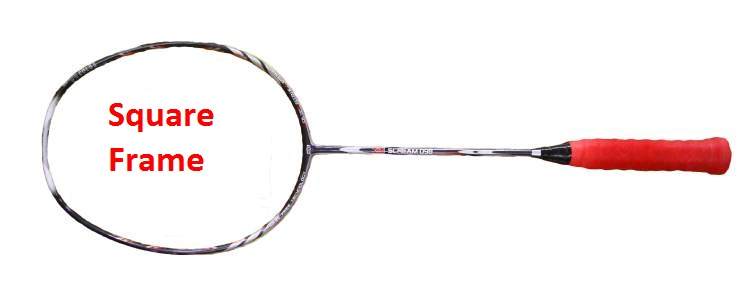
Has a larger sweet spot. Therefore there’s a much higher chance that you’ll perform more quality shots.
Conventional Frames
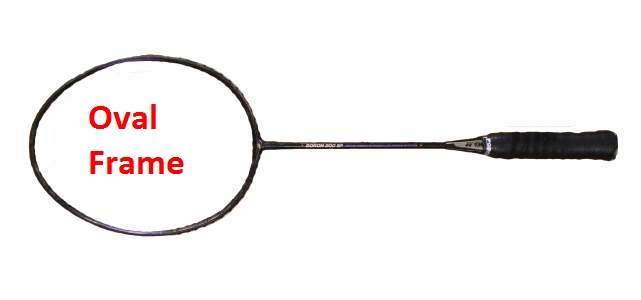
Has a smaller sweet spot. However if the shuttle lands on the sweet spot, it would be a very high quality shot.
Conventional frames are rarely present in the marketplace today because most people prefer isometric shaped rackets.

Tell me what you think!
What do you think about what you just read? Leave me a comment below.